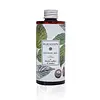What's inside
What's inside
 Key Ingredients
Key Ingredients

No key ingredients
 Benefits
Benefits

 Concerns
Concerns

 Ingredients Side-by-side
Ingredients Side-by-side

Water
Skin ConditioningSodium Coceth Sulfate
CleansingCocamidopropyl Betaine
CleansingDisodium Cocoamphodiacetate
CleansingPolyquaternium-7
Parfum
MaskingOlea Europaea Leaf Extract
PerfumingSalvia Officinalis Leaf Extract
CleansingRosmarinus Officinalis Leaf Extract
AntimicrobialHypericum Perforatum Flower/Leaf/Stem Extract
Skin ConditioningPanthenol
Skin ConditioningSodium Benzoate
MaskingPotassium Sorbate
PreservativeGlycerin
HumectantCitric Acid
BufferingSodium Chloride
MaskingDisodium EDTA
Coumarin
PerfumingWater, Sodium Coceth Sulfate, Cocamidopropyl Betaine, Disodium Cocoamphodiacetate, Polyquaternium-7, Parfum, Olea Europaea Leaf Extract, Salvia Officinalis Leaf Extract, Rosmarinus Officinalis Leaf Extract, Hypericum Perforatum Flower/Leaf/Stem Extract, Panthenol, Sodium Benzoate, Potassium Sorbate, Glycerin, Citric Acid, Sodium Chloride, Disodium EDTA, Coumarin
Water
Skin ConditioningBrassica Campestris Seed Oil
Skin ConditioningIsopropyl Palmitate
EmollientButyrospermum Parkii Butter
Skin ConditioningCocos Nucifera Oil
MaskingCaprylic/Capric Triglyceride
MaskingDimethicone
EmollientGlycerin
HumectantMethylpropanediol
SolventPEG-2 Stearate
EmulsifyingIsopropyl Myristate
EmollientBehenyl Alcohol
EmollientCetearyl Alcohol
EmollientHydroxyethyl Acrylate/Sodium Acryloyldimethyl Taurate Copolymer
Emulsion StabilisingParfum
MaskingHydroxyacetophenone
AntioxidantCeteareth-20
CleansingXanthan Gum
EmulsifyingTocopheryl Acetate
AntioxidantSorbic Acid
PreservativePolysorbate 60
EmulsifyingSorbitan Isostearate
EmulsifyingSodium Hydroxide
BufferingWater, Brassica Campestris Seed Oil, Isopropyl Palmitate, Butyrospermum Parkii Butter, Cocos Nucifera Oil, Caprylic/Capric Triglyceride, Dimethicone, Glycerin, Methylpropanediol, PEG-2 Stearate, Isopropyl Myristate, Behenyl Alcohol, Cetearyl Alcohol, Hydroxyethyl Acrylate/Sodium Acryloyldimethyl Taurate Copolymer, Parfum, Hydroxyacetophenone, Ceteareth-20, Xanthan Gum, Tocopheryl Acetate, Sorbic Acid, Polysorbate 60, Sorbitan Isostearate, Sodium Hydroxide
Ingredients Explained
These ingredients are found in both products.
Ingredients higher up in an ingredient list are typically present in a larger amount.
Glycerin is already naturally found in your skin. It helps moisturize and protect your skin.
A study from 2016 found glycerin to be more effective as a humectant than AHAs and hyaluronic acid.
As a humectant, it helps the skin stay hydrated by pulling moisture to your skin. The low molecular weight of glycerin allows it to pull moisture into the deeper layers of your skin.
Hydrated skin improves your skin barrier; Your skin barrier helps protect against irritants and bacteria.
Glycerin has also been found to have antimicrobial and antiviral properties. Due to these properties, glycerin is often used in wound and burn treatments.
In cosmetics, glycerin is usually derived from plants such as soybean or palm. However, it can also be sourced from animals, such as tallow or animal fat.
This ingredient is organic, colorless, odorless, and non-toxic.
Glycerin is the name for this ingredient in American English. British English uses Glycerol/Glycerine.
Learn more about GlycerinParfum is a catch-all term for an ingredient or more that is used to give a scent to products.
Also called "fragrance", this ingredient can be a blend of hundreds of chemicals or plant oils. This means every product with "fragrance" or "parfum" in the ingredients list is a different mixture.
For instance, Habanolide is a proprietary trade name for a specific aroma chemical. When used as a fragrance ingredient in cosmetics, most aroma chemicals fall under the broad labeling category of “FRAGRANCE” or “PARFUM” according to EU and US regulations.
The term 'parfum' or 'fragrance' is not regulated in many countries. In many cases, it is up to the brand to define this term.
For instance, many brands choose to label themselves as "fragrance-free" because they are not using synthetic fragrances. However, their products may still contain ingredients such as essential oils that are considered a fragrance by INCI standards.
One example is Calendula flower extract. Calendula is an essential oil that still imparts a scent or 'fragrance'.
Depending on the blend, the ingredients in the mixture can cause allergies and sensitivities on the skin. Some ingredients that are known EU allergens include linalool and citronellol.
Parfum can also be used to mask or cover an unpleasant scent.
The bottom line is: not all fragrances/parfum/ingredients are created equally. If you are worried about fragrances, we recommend taking a closer look at an ingredient. And of course, we always recommend speaking with a professional.
Learn more about ParfumWater. It's the most common cosmetic ingredient of all. You'll usually see it at the top of ingredient lists, meaning that it makes up the largest part of the product.
So why is it so popular? Water most often acts as a solvent - this means that it helps dissolve other ingredients into the formulation.
You'll also recognize water as that liquid we all need to stay alive. If you see this, drink a glass of water. Stay hydrated!
Learn more about Water